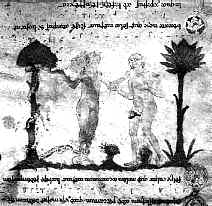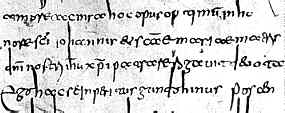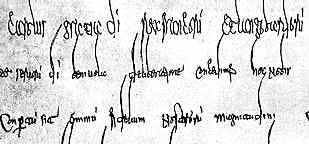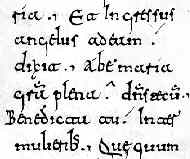|
|
|
|
|
|
 |
|
Post-Roman
Scripts (2) |
|
Scribes in Spain,
from the late 7th century until the 12th, used Visigothic
minuscule, although it also retained a range of the Roman scripts
for some time. Visigothic minuscule was used not only in the Christian
ruled areas of northern Spain, but also by Mozarabic communities, or Christian
groups living under Arab rule in Islamic southern Spain. |
|
Visigothic
script incorporated a number of half
uncial forms and the uncial
G into a base of New
Roman cursive. Ascenders
are strongly wedged. Ligatures
are common. The script is calligraphic
but quite legible. |
|
|
A
fragment of Visigothic minuscule from a 10th century book of Mozarabic
liturgy (British Library, add ms 30844, f.41), by permission of the British
Library. |
|
The
other long lived and highly distinctive script was the Beneventan
minuscule of southern Italy. It survived from the late 8th century
to the 13th. Based around the monastery of Monte Cassino, several local
variants developed and it spread also to Dalmatia. It is rounded and regular
in letter form, with hooked shafts to all the letters. Ligatures are common.
The script is highly formal and calligraphic, but legibility can be a
problem. |
 |
A
distinctive use of the Beneventan script was for exultet
rolls, used for reading the lessons at Easter. The pictures are inverted
with respect to the text so that they could be seen by the congregation
as the roll hung over the edge of the lectern. |
|
Segment
of an exultet roll of the 12th century (British Library, add ms 30337),
by permission of the British Library. The writing is upside down on the
image at left. Below is a detail of the script. |
|
|
|
The
Merovingian,
Lombardic
and Germanic
scripts each encompassed multiple variants, as a range of local scripts
based on New Roman cursive was developed. The terminology
and classification is confused as script styles interacted and
hybridised. For example the assortment classified as Merovingian minuscule ranges from highly mannered and localised variants through to what was to become the more standardised script of later times, quite legible to us today. Paleographers have disputed the definition of Lombardic. While, historically, it ought to represent northern Italian scripts, the term has been confined by some writers to the predecessors of Beneventan minuscule in southern Italy. Some early scripts from northern Italy seem to defy classification under this model. The geographical or stylistic differentiation of Merovingian and Germanic seems to be inconsistent between different writers. The definitions of script styles are not strictly geographic anyway, as early medieval monks were the inventors of academic study leave. The presence of Irish and Anglo-Saxon monks in certain centres on the continent of Europe meant that monasteries in these centres produced works in insular minuscule. |
 |
A
sample originally identified as Lombardic minuscule, later corrected to
Corbie a-b, of the 8th century, part of a Life and Homilies of St Caesarius (Brussels, Bibliothèque Royale MS 9850-52).This example has also been identified as Merovingian. |
 |
Merovingian
book script from an 8th century Evangelary (Autun, Bibliothèque
du Grand Séminaire, 3). |
 |
Sample of 8th century script from Bobbio, an Italian monastery of Irish foundation, of a work of St Augustine (Vienna Library, Cod. lat.16, f.30). |
|
The script in the example immediately above
is described as a mixture of old Italian and Irish book script, which is really stressing the whole concept of National Hands. |
|
In
this somewhat confused situation as regards classification, there were
certain monastic centres which were associated with the production of
minuscule book
hands with particular features. Luxeuil
minuscule developed at the abbey of Luxeuil in France, originally
an Irish foundation, during the 7th and 8th centuries. The abbey was destroyed
by the Saracens in 732, causing the demise of the script, although the abbey was later rebuilt. The script has
a mixture of rounded and angular forms and exaggerated ascenders and descenders.
Uncial and half uncial forms were introduced and there was frequent use
of ligatures. It evidently owes much to Merovingian
chancery script. It could be regarded as a specialised form of Merovingian minuscule, and is identified as such in some older paleographical reference books. |
 |
Small
sample of Luxeuil minuscule from a 7th century lectionary (Paris, Bibliothèque
Nationale, fonds latin 9427, f.143). |
|
Corbie
ab script is generally associated with the daughter foundation of
Luxeuil at Corbie. It is named after the distinctive form of the letters
a and b and
was, in fact, a royal chancery
script adapted as a book hand. It was not the only script in use at Corbie,
nor was it only associated with that place. It also made extensive use
of ligatures, which gives the script the most distinctive aspect of its
appearance. It has also been identified as a form of Merovingian minuscule. |
|
|
Sample
of Corbie ab from a manuscript of c.800 (Imperial Library of St Petersburg,
F. XIV,1). |
|
New
Roman cursive was also ancestral to various administrative and business
hands and certain chanceries developed very elaborate and stylised versions.
The script of the papal curia up to the 10th century, curialis
or littera Romana,
and the related Ravenna
chancery script were highly exaggerated calligraphic scripts with
long ascenders and descenders, loops and ligatures; very impressive but
not highly legible. Merovingian
chancery script was employed in the writing office of the early Frankish
kings. Stylised, elongated and spidery, it could also be extremely illegible. |
 |
Merovingian
chancery script in a diploma of Charlemagne from AD 781 (State Archives,
Marburg). |
 |
|
The
spidery appearance of papal curialis, from a privilage of John VIII on
papyrus, of 876 (Paris, Bibliothèque Nationale, Ms.lat.8840). |
|
The
interaction between the various forms of cursive,
the borrowings back from the formal New
Roman scripts such as uncial and half uncial, the development of localised
calligraphic flourishes and the mutual interactions which led to developments
of script are difficult to trace in detail. The erratic survival of 8th
century manuscripts plays a large part in this. However, it is fair to
say that the development of handwriting in western Europe was in a phase
of diversification. |
|
In
the court of Charlemagne, among burgeoning interest in literary and classical
culture, a script was developing which would eventually standardise handwriting
across much of western Europe. Its origins were in the book hands derived
from cursive, but it was very formal, regular and legible. This was Caroline
minuscule. But first, let us take a slightly different viewpoint on this earlier era. |
|
continued  |
 previous
page previous
page |
 History
of Scripts History
of Scripts |
 What
is Paleography? What
is Paleography? |
|
 |
 |
 |
 |
 |
 |









